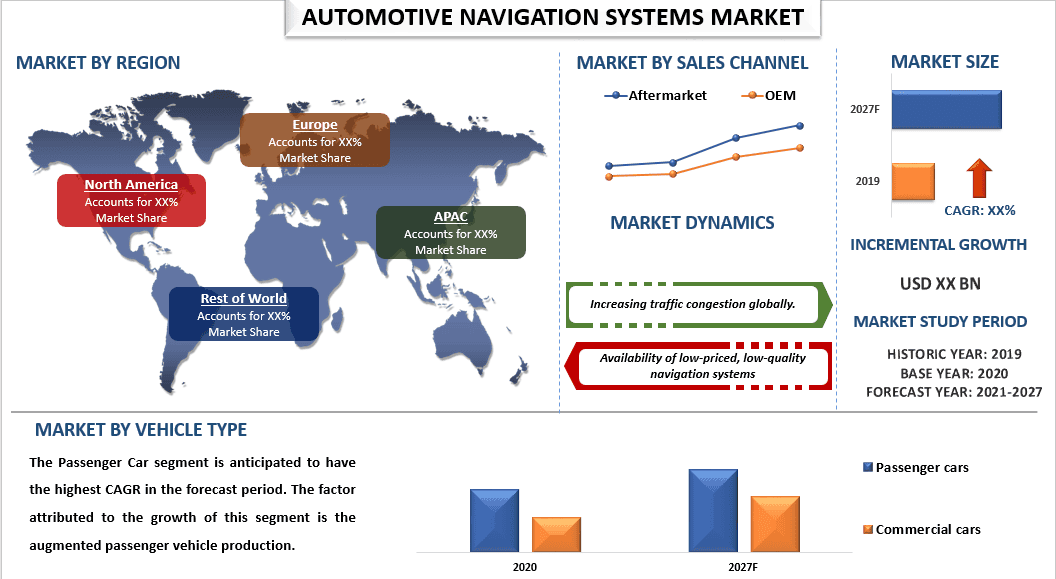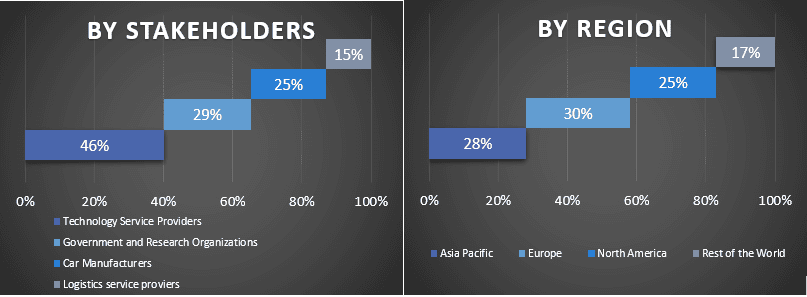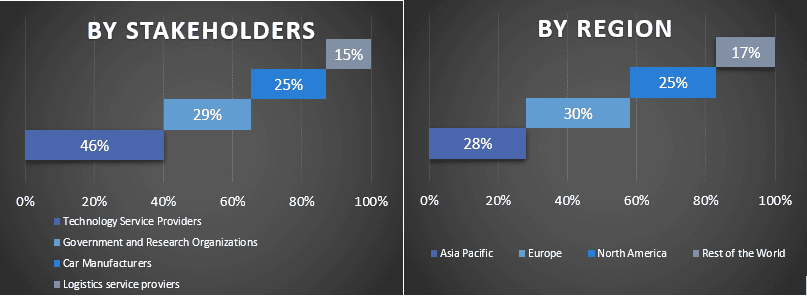Emphasis on Sales Type (OEM, Aftermarket), Vehicle Type (Passenger cars, Commercial vehicles), and Region/Country.

The automotive navigation system market is expected to grow at a CAGR of around 8% during the forecast period. The integration of smartphones and IVS (In-Vehicle Systems) are the key factors contributing to the growth of the market. In recent years, smartphones have become widespread and demand for smartphone / tablet-based navigation devices is expected to grow. Real-time traffic data, map updates, and smartphone integration are just a few of the key features of automotive navigation systems and could attract significant customer demand over the next few years. In addition, advances in navigation system technology coupled with the increasing concerns related to the problem of traffic congestion, particularly in urban areas, and changing consumer behavior, towards better in-dash features are the key factors driving the growth of the automotive navigation systems market.
Major companies in the industry are DENSO Corporation, Harman International Industries Inc., Clarion Co. Ltd, Continental Reifen Deutschland GmbH, Aisin AW Co. Ltd, TomTom International BV, JVC Kenwood Corporation, Panasonic Corporation, Mitsubishi Electric Corporation.
Insights Presented in the Report
“Amongst vehicle type, passenger car category accounted for the majority share in the market in 2020”
Based on vehicle type, the market is bifurcated into passenger cars and commercial vehicles. The Passenger Car segment is anticipated to have the highest CAGR in the forecast period. Growing passenger car production across the globe is one of the prominent reasons driving the growth of this segment. The entire production of passenger cars improved in recent years. Therefore, the growing production of passenger vehicles is resulting in the demand for navigation systems, globally.
“Amongst sales channel, the aftermarket segment is expected to witness the highest CAGR during the forecast period”
Based on the sales channel, the market is bifurcated into OEM and Aftermarket. The Aftermarket segment is predicted to hold the most significant CAGR in the forecast period. The factors can be attributed to the fitment rate from the aftermarket channels as older cars do not come with an already fitted navigation system. Customers who require a navigation system in their vehicle can get it from the aftermarket.
“Asia Pacific to witness significant growth during the forecast period”
The Asia Pacific is a prominent region in the global automotive navigation systems market, expected to account for a substantial market share during the forecast period. The presence of large manufacturers in the region, growing urbanization, rising income, and increasing consumer demand are some of the prominent reasons contributing to the growth of the region. Furthermore, the region experienced rapid smartphone adoption with China and India being the key automotive navigation systems market in this region. Moreover, the competition in these countries in the automotive industry is growing very rapidly. Asia-Pacific is projected to become the key market for automotive navigation systems with Japan, India, and China, being the major automotive manufacturing hubs during the forecast period. Moreover, the demand across North America and Europe region is likely to increase due to the penetration of automobile MEMS sensors as it is one of the emerging applications and is being used in the electronic control unit, and tire pressure monitoring systems in the automotive navigation systems market.
Reasons to buy this report:
Customization Options:
The global Automotive Navigation Systems market can further be customized as per the requirement or any other market segment. Besides this, UMI understands that you may have your own business needs, hence feel free to connect with us to get a report that completely suits your requirements.
1. Market Introduction
2. Research Methodology Or Assumption
3. Market Synopsis
4. Executive Summary
5. Global Automotive Navigation Systems Market Covid-19 Impact
6. Global Automotive Navigation Systems Market Revenue (usd Bn), 2019-2027f
7. Market Insights By Sales Channel
8. Market Insights By Vehicle Type
9. Market Insights By Region
10. Automotive Navigation Systems Market Dynamics
11. Automotive Navigation Systems Market Opportunities
12. Automotive Navigation Systems Market Trends
13. Policy & Regulatory Framework
14. Demand And Supply-side Analysis
15. Value Chain Analysis
16. Competitive Scenario
17. Company Profiled
18. Disclaimer
Research Methodology for the Global Automotive Navigation Systems Market Analysis (2021-2027)
Analyzing the historical market, estimating the current market, and forecasting the future market of the global automotive navigation systems market were the three major steps undertaken to create and analyze the adoption of automotive navigation systems in major regions globally. Exhaustive secondary research was conducted to collect the historical market numbers and estimate the current market size. Secondly, to validate these insights, numerous findings and assumptions were taken into consideration. Moreover, exhaustive primary interviews were also conducted, with industry experts across the value chain of the global automotive navigation systems market. Post assumption and validation of market numbers through primary interviews, we employed a top-down/bottom-up approach to forecasting the complete market size. Thereafter, market breakdown and data triangulation methods were adopted to estimate and analyze the market size of segments and sub-segments of the industry pertains to. Detailed methodology is explained below:
Seek More Details About Research Methodology
Analysis of Historical Market Size
Step 1: In-Depth Study of Secondary Sources:
Detail secondary study was conducted to obtain the historical market size of the automotive navigation systems market through company internal sources such as annual reports & financial statements, performance presentations, press releases, etc., and external sources including journals, news & articles, government publications, competitor publications, sector reports, third-party database, and other credible publications.
Step 2: Market Segmentation:
After obtaining the historical market size of the automotive navigation systems market, we conducted a detailed secondary analysis to gather historical market insights and share for different segments & sub-segments for major regions. Major segments are included in the report as vehicle type and sales channel. Further country-level analyses were conducted to evaluate the overall adoption of testing models in that region.
Step 3: Factor Analysis:
After acquiring the historical market size of different segments and sub-segments, we conducted a detailed factor analysis to estimate the current market size of the automotive navigation systems market. Further, we conducted factor analysis using dependent and independent variables such as various Vehicle types and sales channels of automotive navigation systems. A thorough analysis was conducted for demand and supply-side scenarios considering top partnerships, mergers and acquisitions, business expansion, and product launches in the Automotive Navigation Systems market sector across the globe.
Current Market Size Estimate & Forecast
Current Market Sizing: Based on actionable insights from the above 3 steps, we arrived at the current market size, key players in the global automotive navigation systems market, and market shares of the segments. All the required percentage shares split, and market breakdowns were determined using the above-mentioned secondary approach and were verified through primary interviews.
Estimation & Forecasting: For market estimation and forecast, weights were assigned to different factors including drivers & trends, restraints, and opportunities available for the stakeholders. After analyzing these factors, relevant forecasting techniques i.e., top-down/bottom-up approach were applied to arrive at the market forecast about 2027 for different segments and sub-segments across the major markets globally. The research methodology adopted to estimate the market size encompasses:
Market Size and Share Validation
Primary Research: In-depth interviews were conducted with the Key Opinion Leaders (KOLs) including Top Level Executives (CXO/VPs, Sales Head, Marketing Head, Operational Head, and Regional Head, Country Head, etc.) across major regions. Primary research findings were then summarized, and statistical analysis was performed to prove the stated hypothesis. Inputs from primary research were consolidated with secondary findings, hence turning information into actionable insights.
Split of Primary Participants in Different Regions

Market Engineering
Data triangulation technique was employed to complete the overall market estimation and to arrive at precise statistical numbers of each segment and sub-segment of the global automotive navigation systems market. Data was split into several segments & sub-segments post studying various parameters and trends in the areas of vehicle type and sales channel in the global automotive navigation systems market.
The main objective of the Global Automotive Navigation Systems Market Study
The current & future market trends of the global automotive navigation systems market were pinpointed in the study. Investors can gain strategic insights to base their discretion for investments on the qualitative and quantitative analysis performed in the study. Current and future market trends determined the overall attractiveness of the market at a regional level, providing a platform for the industrial participant to exploit the untapped market to benefit from a first-mover advantage. Other quantitative goals of the studies include:
Deep dive regional level analysis of the industry

Customers who bought this item also bought